Early Bible Translations Collection (15 vols.)
Digital Logos Edition
Overview
Featuring fifteen historically significant volumes, the Early Bible Translations collection includes English translations of some of the earliest biblical language texts and translations of the Bible from seven respected translators. These translations contributed to a renewed interest in these original language texts, making them more accessible to an English-speaking audience. This collection includes:
- Charles Thomson’s English translation of the Greek Bible, both the Septuagint and the New Testament
- James Murdock’s English translation of the Syrian New Testament
- Agnes Smith Lewis’ English translation of the Four Gospels from the Syriac of the Sinaitic Palimpsest
- Francis Crawford Burkitt’s English translation of the Curetonian Version of the Four Gospels
- J.W. Etheridge’s English translation of the Targums of Onkelos and Jonathan ben Uzziel on the Pentateuch
- C.W.H. Pauli’s English translation of the Chaldee Paraphrase on the Prophet Isaiah, also known as the Targum Isaiah
- J.W. Etheridge’s English translation of the New Testament from the Peshitta
- William Norton’s Peshito-Syriac and Greek comparison of Hebrews, James, 1 Peter, and 1 John
- J.W. Etheridge’s in-depth look into the English translation of Matthew and Hebrews from the ancient Syriac
The volumes in the Early Bible Translations (15 vols.) collection continue to be of scholarly use today in the study of the textual transmission of the Bible and in the historical study of Christian theology. The Early Bible Translations (15 vols.) collection is your direct link for studying some of the earliest cultures who read the Bible, providing context for how they read and interpreted it.
You can also use the Text Comparison Tool for a side-by-side comparison of your preferred Bible translation with each of these volumes. The Early Bible Translations (15 vols.) collection is fully integrated with the other resources in Logos, including maps, dictionaries, encyclopedias, and numerous other Bible study tools, and you can link them with the original language texts and tools in your library, such as The Peshitta and the German Bible Society Bundle. This makes the Early Bible Translations (15 vols.) collection more powerful and easier to access than ever before for reading, translations, sermon preparation, research, and Bible study.
Volumes 1 and 2 of The Targums of Onkelos and Jonathan ben Uzziel on the Pentateuch will be downloaded as one resource.
Evangelion da-Mepharreshe: The Curetonian Version of the Four Gospels, vol. 1 will be downloaded as two resources: Translation and Text.

- English translations of some of the earliest original language texts of the Bible
- These translations offer a unique double value: evidential and exegetical
- Important works for the study of the Old and New Testaments
- Title: Early Bible Translations
- Volumes: 15
- Pages: 6,704
- The Old Covenant, Commonly Called the Old Testament: Translated from the Septuagint, Volume 1
- The Old Covenant, Commonly Called the Old Testament: Translated from the Septuagint, Volume 2
- The Old Covenant, Commonly Called the Old Testament: Translated from the Septuagint, Volume 3
- The New Covenant, Commonly Called the New Testament: Translated from the Greek, Volume 4
- The Syriac New Testament: Translated into English from the Peshitto Version
- Some Pages of the Four Gospels Re-Transcribed from the Sinaitic Palimpsest with a Translation of the Whole Text
- Evangelion da-Mepharreshe: The Curetonian Version of the Four Gospels, Volume 1
- Evangelion da-Mepharreshe: The Curetonian Version of the Four Gospels, Volume 2
- The Targums of Onkelos and Jonathan ben Uzziel on the Pentateuch, Volume 1
- The Targums of Onkelos and Jonathan ben Uzziel on the Pentateuch, Volume 2
- The Chaldee Paraphrase on the Prophet Isaiah Translated
- The Syrian Churches: Their Early History, Liturgies, and Literature
- The Apostolical Acts and Epistles, from the Peschito, or Ancient Syriac: To which are Added, the Remaining Epistles, and the Book of Revelation
- A Translation in English Daily Used of the Peshito-Syriac Text
- Horae Aramaicae
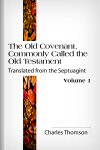
Charles Thomson’s translation of the Greek Bible (both the Septuagint and the New Testament) was an important "first." It was the first English Bible translation in America, the first translation of the Septuagint into English—perhaps any modern language—and the first Bible printed by a woman. Thomson chose the Septuagint as the basis for his translation because it was the earliest available text of the Old Testament in any language. Volume 1 begins the Old Testament through the end of 1 Samuel.
Charles Thomson was a contemporary and friend of George Washington, a key figure in the American Revolution as Secretary of Congress from 1774-1789, and an avid scholar. He was a man of great knowledge and integrity, so much so that when disagreement arose in Congress, they would call on him to verify disputed points by saying, "Let us have truth or Thomson," though other accounts present the phrase as "Here comes Truth—here comes Charles Thomson." Either way, his words were considered equal to any other man’s oath. As Secretary, he was a signer of the Declaration of Independence, ex officio. His last act as Secretary was to deliver the notification to George Washington that he had been elected President in 1789. After that, he began working on his translation of the Greek Old and New Testaments which he completed and published in 1808. After completing his translation, Thomson wrote his Synopsis of the Four Evangelists, which used his own translation as its basis.

Volume 2 of Charles Thomson’s translation continues with 2 Samuel and moves through the Psalms. Through all three volumes, Thomson does not follow the ordering of Old Testament books found in Septuagint manuscripts, but instead follows the traditional English order. Thomson’s work of translation took well over twenty years, and the majority of it was done in his quaint stone cottage in the country just outside Bryn Mawr. He carefully worked through the entire text of his translation at least four times before sending it to the printer for publishing.
Thomson’s achievement is remarkable for its depth of scholarship.
—Paul C. Gutjahr, An American Bible: A History of the Good Book in the United States, 1777-1880
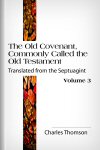
Volume 3 of Charles Thomson’s translation begins with Proverbs and continues through the rest of the Old Testament. Thomson did not include the deuterocanonical books known as the Apocrypha in his work, choosing instead to present only the Protestant canon.
Thomson’s excellent translation was several times referred to by the Revision Committee, and always with great respect . . . even any novel suggestion it made would be thought worth looking into.
—Thomas Chase, President of Haverford College and member of the American Standard Version’s translation committee
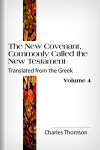
Thomson’s central concern in making his translation was biblical credibility and authenticity. He lived in the era of growing skepticism over the historical accuracy Jesus’ claims and the general reliability of the Bible. Thus the other central goal of his work was to show that when New Testament authors quoted the Old Testament, they consistently used the Septuagint. Thomas firmly held the view that an accurate, reliable translation of the LXX would vindicate the genuineness of the biblical message.
Thomson’s translation is favorably regarded by biblical scholars today.
—Bruce Manning Metzger
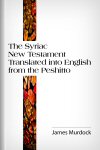
The Syriac New Testament has a unique double value: evidential and exegetical. As an early translation of the New Testament, it is highly valued both for textual criticism and exegesis. James Murdock’s translation makes available in English this important version for the study of the New Testament. This particular edition also includes a convenient introduction to the Syriac New Testament, its origins, and history as well as a biography of the translator provided by the publisher. The volume concludes with two appendixes. The first divides the translation into reading lessons and the second presents a survey of the various Syriac translations of the Greek New Testament, outlining not only the Peshitta, but also the other Syriac versions: the Curetonian, Philoxenian, Harclensian, and Jerusalem translations.
The Syriac text used by the translation is that printed by the British and Foreign Bible Society in 1816 by Claudius Buchanan and Samuel Lee, Professor of Arabic at Cambridge. Deviations of the Syriac text from the Greek are noted in the side margins. This makes it possible to quickly and easily compare the Syriac with the Greek New Testament.
For forty years or thereabout [Murdock’s translation] has been recognized as a work of great and exact scholarship.
—Bibliotheca Sacra, 1894
James Murdock was professor at Andover Theological Seminary and a first class polyglot, being quite at home in Arabic, Sanskrit, Hebrew, Greek, Syriac, and German. He wrote his own grammars of both Syriac and Arabic and translated the Syriac New Testament in 1846 and it was published just before his death in 1856.
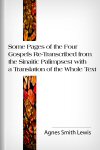
The discovery of the Sinaitic Palimpsest by Agnes Smith Lewis continues to be recognized among New Testament textual critics and Syriac scholars as an incredibly important find. While the Peshitta is recognized as the standard New Testament version for Syriac speakers generally, it is the Old Syriac version that represents the oldest available text in the language. The Sinaitic Palimpsest is one of only two manuscripts that represent the Old Syriac version.
Agnes Smith Lewis makes this important resource accessible in English translation. Valuable for anyone interested in textual criticism, ancient Bible translations, early Christian history, and other related topics, Some Pages of the Four Gospels Re-Transcribed from the Sinaitic Palimpsest with a Translation of the Whole Text brings to English speakers this essential ancient text.
To all students of the Bible, the appearance of this first authorized translation from the Sinai palimpsest must be an event of great interest.
—The New World, 1895
Agnes Smith Lewis (PhD, LLD, DD, LittD) lived from 1843 to 1926. She and her sister, Margaret Dunlop Gibson (1843–1920), were known as the Westminster Sisters. Both Semitic scholars, they together had studied more than twelve languages. They were pioneers in academic research, particularly in Syriac research. Each sister had married in the 1880’s, but both of their husbands passed away. In 1890, together they began the study of Syriac and Arabic. They traveled to St. Catherine’s Monastery at Mount Sinai in 1892 where they discovered the Sinaitic Palimpsest. The two sisters used their inheritance to endow Westminster College at Cambridge in 1899. For the sister’s extensive biblical and theological research, the University of St. Andrews, the University of Heidelberg, and the University of Dublin all awarded them honorary doctorates—including the first theological doctorates ever awarded to any woman.
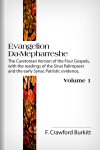
Volume 1 of Francis C. Burkitt’s Evangelion da-Mepherrashe contains the Syriac text and English translation of the Old Syriac manuscript Curetonianus. The print edition presents the text and translation in parallel columns on facing pages in diglot form. The Syriac text follows Curetonianus wherever it is extant and the Sinaitic Palimpsest where it is not. A brief apparatus is also provided in order to show the differences between Curetonianus and the Sinaitic Palimpsest. His translation freshly and literally presents the text, attempting to provide a concordant translation with a given Syriac word always being translated with the same English word if possible. This makes it possible for the student and scholar to gain a basic idea of the text contained in the manuscript.
Francis Crawford Burkitt was a British scholar who lived from 1864 until 1935. He was Norris Professor of Divinity at the University of Cambridge from 1905 to 1934. His academic focus was the reception of the New Testament and textual criticism. He is known both for the critical stance he took on the notion of the Caesarean text type proposed by B.H. Streeter and also for his standard edition of Curetonianus, one of two known existing Old Syriac New Testament manuscripts.
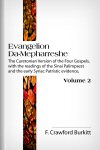
The second volume of Burkitt’s Evangelion da-Mepharreshe contains grammatical observations, text-critical notes, and commentary on select passages from Codex Curetonianus and the Old Syriac version in general. He provides invaluable comparisons with both the Greek New Testament and also the more well-preserved Peshitta version of the Syriac New Testament.
Burkitt’s massive work is the best attempt to gather and arrange all the light thrown upon the New Testament text by the Syriac versions and other Syriac testimony.
—Books for New Testament Study: Popular and Professional
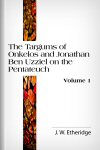
The Targums of Onkelos and Jonathan ben Uzziel on the Pentateuch offers readers English translations of two important volumes of Aramaic paraphrases on the Books of the Old Testament. The translation, made directly from the Chaldee, is strictly ad literam, and preserves the idiomatic characteristics of the original. The first volume includes an in-depth introduction on the origin, history, and character of the Targums, and the translations of Genesis and Exodus.
We commend this important book to all students of the word of God, and especially to those who wish to trace the providential links which bind together the Church of Moses and the Church of Christ.
—The London Quarterly, 1862
John Wesley Etheridge (1804–1866) was born near Newport, Isle of Wight. A Wesleyan Methodist preacher, Etheridge received much of his early education from his father and was particularly adept at learning languages—at a young age he was fluent in Greek, Latin, Hebrew, Syriac, French, and German. He earned his Ph.D. from the University of Heidelberg and, along with the translation of the Targums, authored several major works, including Horae Aramaicae, The Apostolic Acts and Epistles, from the Peshito or Ancient Syriac, and Jerusalem and Tiberias, a Survey of the Religious and Scholastic Learning of the Jews.
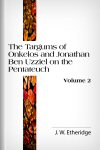
Volume two of The Targums of Onkelos and Jonathan ben Uzziel on the Pentateuch includes a 76-page glossary for both volumes and the translations for Leviticus, Numbers, and Deuteronomy.
A good service has been rendered to biblical students by the publication of this volume. It enables Englishmen of the present day to appreciate the forms of thought prevalent in the times of the apostles, and will, we have no doubt, satisfactorily account to them for the use of words and phrases in the New Testament which have seemed to be hard to understand. In this way it will confirm the faith of many, and be accepted by all intelligent readers as a valuable contribution towards a history of the interpretation of the Hebrew Scriptures.
—The Baptist Magazine, 1863
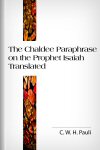
The Chaldee Paraphrase on the Prophet Isaiah, or the Targum Isaiah, offers readers the English translation of the Aramaic paraphrase on the Book of Isaiah. Logos users will find the Paraphrase a welcome help with many difficult passages in the Book of Isaiah. Pauli has followed the text of the Biblia Magna Hebraica and has included three indices.
C.W.H. Pauli (1800-1877) was a Christian convert and missionary for London’s Society House in Berlin and Amsterdam. He is also the author of Analecta Hebraica and The Great Mystery, or How can Three Be One.
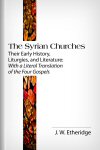
J.W. Etheridge provides a comprehensive introduction to the ancient Syrian Church before providing English translations of the four Gospels directly from the Syriac language. The object of the translation is to offer in English an accurate representation of these venerable Eastern scriptures. In order to preserve the air and manner, as well as meaning of the original, Etheridge has retained the Syrian orthography of the proper names, and has left some of the peculiar denominatives of the gospel narrative untranslated.
The Peshito, it is true, has found a competent translator among us in the person of Dr. John W. Etheridge, a Wesleyan Minister, whose high-toned, beautiful, and elaborate works on the Syrian Churches and on Hebrew literature entitle him to the warmest thanks of all Christian scholars.
—The London Review, 1860
A great mass of information which will be new to most English readers. His materials are derived from the best sources of information. His work fills up an important chasm in ecclesiastical history, and is well deserving of a place in every well-assorted ecclesiastical library.
—Church of England Quarterly Review
John Wesley Etheridge (1804–1866) was born near Newport, Isle of Wight. A Wesleyan Methodist preacher, Etheridge received much of his early education from his father and was particularly adept at learning languages—at a young age he was fluent in Greek, Latin, Hebrew, Syriac, French, and German. He earned his Ph.D. from the University of Heidelberg and, along with the translation of the Targums, authored several major works, including Horae Aramaicae, The Apostolic Acts and Epistles, from the Peshito or Ancient Syriac, and Jerusalem and Tiberias, a Survey of the Religious and Scholastic Learning of the Jews.
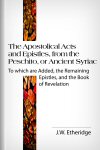
The Apostolical Acts and Epistles, from the Peschito, or Ancient Syriac: To which are Added, the Remaining Epistles, and the Book of Revelation
- Author: J.W. Etheridge
- Translator: J.W. Etheridge
- Publisher: Longman, Brown, Green, and Longmans
- Publication Date: 1849
- Pages: x, 508
This volume completes J.W. Etheridge’s translation of the Syriac New Testament, began in The Syrian Churches: Their Early History, Liturgies, and Literature. In the introductory Prolegomena, Etheridge provides a useful review of the various ancient translations of the Scriptures and a synopsis of the Apostolic Epistles. Like The Syrian Churches, the translation has been made directly from the Syriac and is rendered as literally as the structure of the two languages will allow. This volume also contains two in-depth indices.
Dr. Etheridge has conferred no ordinary obligation on students in biblical literature, by the publication of this volume. It is pleasing to see the close agreement of the text from which our authorized version was rendered, with that which the Syriac translators must have had before them.
—Wesleyan Methodist Magazine
To unquestionable competence on the score of learning, Dr. Etheridge adds a profound reverence for the sacred records, and the zeal of an enlightened theologian. His Prolegomena contains much valuable information.
—Evangelical Christendom
John Wesley Etheridge (1804–1866) was born near Newport, Isle of Wight. A Wesleyan Methodist preacher, Etheridge received much of his early education from his father and was particularly adept at learning languages—at a young age he was fluent in Greek, Latin, Hebrew, Syriac, French, and German. He earned his Ph.D. from the University of Heidelberg and, along with the translation of the Targums, authored several major works, including Horae Aramaicae, The Apostolic Acts and Epistles, from the Peshito or Ancient Syriac, and Jerusalem and Tiberias, a Survey of the Religious and Scholastic Learning of the Jews.
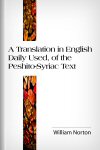
In this volume, William Norton compares and translates into common English the Peshito-Syriac text and the Received Greek text of Hebrews, James, 1 Peter, and 1 John side-by-side. By comparing the common English translation of the Peshito-Syriac text with that of the Received Greek text, Norton argues that the Revised Version of 1881 was based on a corrupted, newly formed Greek text, and therefore partly mistranslated. Norton advocates the primacy of the Peshitta, believing it to be the closest text to the original New Testament.
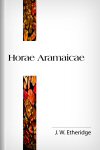
This volume, while including English translations of the Gospel of Matthew and the Hebrew Epistle from the ancient Syriac, contains great explanations of the various Aramean dialects and of the different versions of the Bible extant in them. Providing in-depth introductions to both New Testament works, Etheridge compares the Syriac translations with the Greek texts, offering the view that these works should be studied in the original vernacular dialect of ancient Judea.
John Wesley Etheridge (1804–1866) was born near Newport, Isle of Wight. A Wesleyan Methodist preacher, Etheridge received much of his early education from his father and was particularly adept at learning languages—at a young age he was fluent in Greek, Latin, Hebrew, Syriac, French, and German. He earned his Ph.D. from the University of Heidelberg and, along with the translation of the Targums, authored several major works, including Horae Aramaicae, The Apostolic Acts and Epistles, from the Peshito or Ancient Syriac, and Jerusalem and Tiberias, a Survey of the Religious and Scholastic Learning of the Jews.
Reviews
4 ratings
Phil Niebergall
1/10/2020

Raymond Sevilla
9/22/2015
AeliusCicero
8/7/2015

Unix
5/9/2014
Raise bids on "English Bible Collection (27 vols.)" instead - it contains an important Reformationra work (Geneva Bible), as well as the latest NT Bible version based on the TR: the 1865/1866 Common English Version New Testament. Bid high - it will never make it into production without many more bidding much higher than $30. For History-minded people I also recommend: https://www.logos.com/product/33266/encyclopedia-britannica ... from the just-before-WWI-era (see my comments/reviews though - my current bid for it is $180 with two accounts).
Rob
4/9/2014
Charles Thomson's four-volume translation of the Septuagint into English was the first translation of the Bible from Greek texts on the North American Continent. He translated the texts from a simple stone farm house in near-by Bryn Mayr, PA during his retirement after serving as Secretary of the Continental Congresses
Phil Gons
7/14/2013

Jon Kennedy
3/15/2013
If you're interested in early Bible translations, then be sure and bid on the English Bible Collection (27 vols.). It has the Geneva Bible, the Wycliffe Bible, the Tyndale Bible, the Matthew Bible, the Coverdale Bible and more.